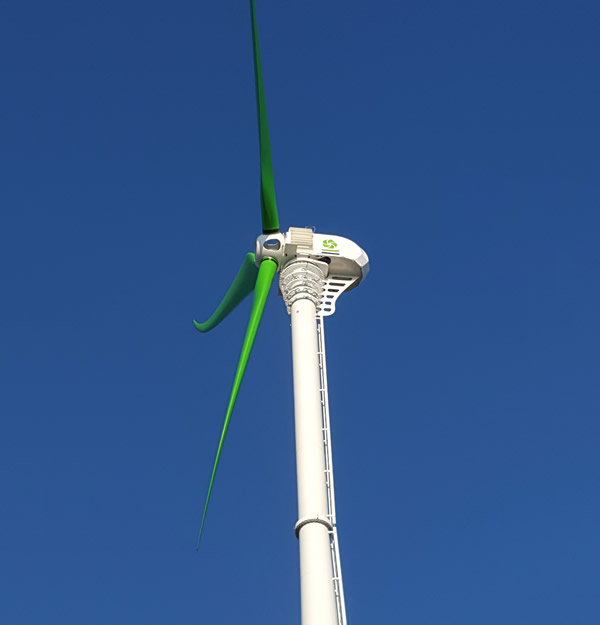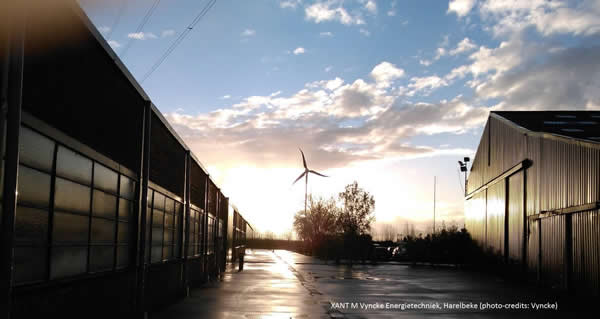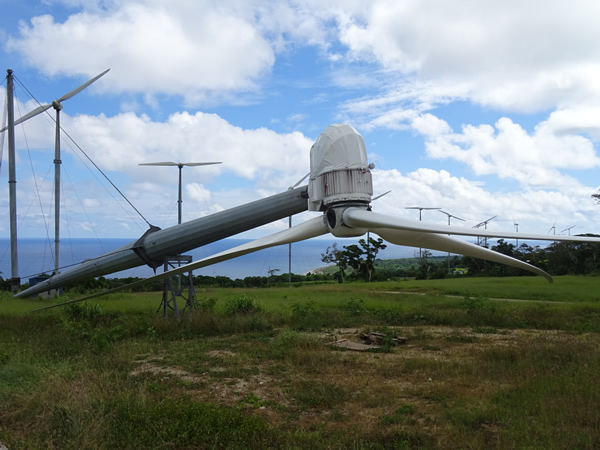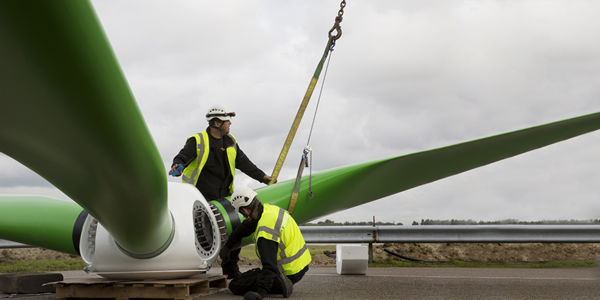
XANT Midsize Turbine
The economics of distributed wind projects, ones that use small and medium-size turbines, could be looking promising as interest builds in the development of hybrid distributed energy development. The addition of wind can sweeten the financial performance of solar-plus-storage projects, but the calculation is technically and economically complex. That’s one reason the latest release of HOMER Grid incorporates a wind module. We encourage our users to model diverse system configurations and decide whether wind is a potential fit. The results might be surprising, and the software will help weigh the complex variables involved in determining the best combination of components.
In recent decades, economies of scale have unambiguously favored large turbines and wind farms, and “big wind” has grown rapidly. But, small and medium scale wind manufacturers operate with a completely different business model – the behind the meter market, where energy generated by the wind turbine is consumed on site.
Since US incentives for small/medium wind have been recently restored (through a February 2018 Congressional appropriations bill), manufacturers and project developers for this segment of the industry are more optimistic about their prospects. The same is true in Europe, where some countries are considering feed-in tariffs and other incentives for small wind. Now it’s easier to see that there are several important economic niches for small and medium-scale wind.

XANT Turbine Powering Agriculture
Small and Medium Wind are Poised for Growth
Despite continuing declines in the cost of solar PV, which can compete with wind, a number of experts are predicting steady expansion of the small / medium-scale wind market. Navigant Research reported in 2017 that the global installed capacity of small and medium wind turbines was expected to grow from 176.4 MW in 2017 to 446.0 MW in 2026.
First, there are the logistical considerations. “There are a lot of places in the world where a 5MW wind turbine cannot get. One of those important places is behind the meter,” says Alex De Broe, CEO of XANT, a European manufacturer of medium-scale wind turbines. De Broe says that of the locations where electricity will be consumed in the same place that it is generated, the best prospects for distributed wind include islands, farms, corporate campuses and industrial parks, remote rural electrification projects in developing countries, ports, and populated areas. XANT makes a “tilt-up” wind tower that can be hoisted into place without a crane, ideal for islands or remote environments where a crane is not an option, or in typhoon-prone areas where the turbine can be lowered in emergencies. XANT turbines are also designed to be quiet so they can be used in semi-populated areas.

XANT Turbine Ready for Tilt-Up
Russell Tencer, CEO of United Wind, which supplies small turbines to farmers and residential users, points out that despite the demand for small wind, predictable incentives are key to the success of the US industry. He says that when the tax credits for small wind were reinstated in early 2018, that changed everything. “I think we have a good thing ahead of us now because the policy has stabilized, and the market for distributed wind hasn’t been fully realized yet,” he said. Tencer adds that one of the big problems with small and medium wind has always been the financing, which is more challenging than it is for PV projects. In response, United Wind has developed a leasing model, which so far seems to be working. The company’s market is growing as a result.
Mike Bergey of Bergey Windpower is encouraged about the prospects for the small wind turbines that are his company’s specialty, and says that while manufacturers have struggled recently to compete with the plummeting cost of solar PV, that may soon be changing. For decades his company, with its roots in aviation design, has been a leader of the small wind industry, and has a loyal fan base around the world. Bergey sales are mainly aimed at residential and agricultural customers, and the best selling product has long been a 10kW turbine. But, Bergey says the company is introducing a new 15kW turbine that may expand his market to more commercial users; it produces double the energy at half the relative cost of the smaller turbine, and follows the example of large wind by improving the aerodynamics of rotors and taking advantage of economies of scale. “Our turbines are good in populated areas, and one of the things that works well is the seasonal complementarity of wind and solar; if there’s a good wind resource, and if you combine wind and solar in the same distributed energy system, you get better cost reduction and greater renewable energy penetration.”

XANT Installation Assembly
Small and Medium Wind Will Play a Key Role in XANT Hybrid Systems
Alex De Broe of XANT also reminds us that while the installation and investment costs of wind are higher than solar, wind is more productive. “A wind turbine will produce significantly more electricity than solar per installed kilowatt of capacity” he says. The median capacity factor of onshore wind is 38% while solar PV is only 20%. “Solar PV has gained so much momentum that people have lost sight of the advantages of other renewable-energy technologies,” says De Broe. “We don’t see wind and PV as competing technologies in the distributed-generation space. Rather they are complementary technologies to enable – together with storage and DSM – an all-renewable electricity supply.” XANT targets commercial and industrial customers who want to produce their electricity on site. One example is a water treatment plant where the settling tanks have taken up most of the land. In that situation, when the land area is scarce, combined with a 24/7 electricity need, a wind turbine is the perfect solution.
Many of XANT’s other customers already have their roofs covered with PV panels and they want to increase their onsite renewable energy generation by integrating wind. One large European company has an industrial site where dredging ships are docked. They want to showcase their sustainability and ultimately aim to be carbon neutral. They also want the capability to disconnect from the grid. Another XANT customer is a Tesla second-hand car dealer who has a 100kW PV array on the roof, a 400 kWh battery, and a 95kW XANT turbine; there’s also a neighboring cold storage facility that has huge electricity demands, but that can buffer its consumption by slightly raising the temperature. De Broe is using HOMER Grid in these complex scenarios to model and determine the optimal system configuration for each customer.
HOMER Software Facilitates Modeling of Wind with Storage
It may seem counterintuitive, but over the course of a day, wind output produces fewer problematic peaks and valleys than solar. When the sun goes down, electricity production from large PV systems drops precipitously, causing the infamous “duck curve.” Wind, on the other hand, has a more steady production profile, at least in areas where there is a good wind resource. Wind turbines can produce energy throughout the day and night, and that’s what makes wind and solar complementary. Bergey uses HOMER software to model distributed energy projects and says he will soon be looking more closely at the integration of wind and storage for farmers and commercial customers. Small users pay higher electricity rates than large industries, which makes the energy generated by local renewable resources more valuable for them, says Bergey. “Like with solar, storage is going to help the wind industry. Your software will be very useful in helping to define that sweet spot where the rates are higher, such that a small turbine – even if it costs more to install than solar – would be economical. The key to that is because the value of the energy is higher. It requires a sophisticated analytical tool like HOMER to tease out those situations.”
